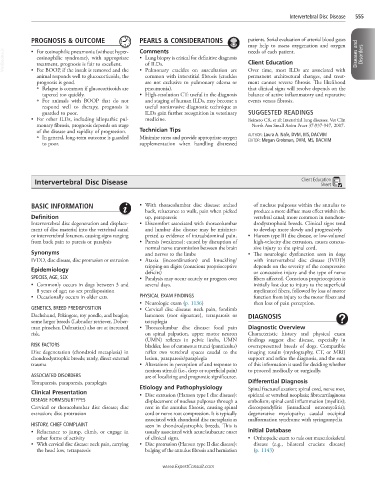Page 1113 - Cote clinical veterinary advisor dogs and cats 4th
P. 1113
Intervertebral Disc Disease 555
PROGNOSIS & OUTCOME PEARLS & CONSIDERATIONS patients. Serial evaluation of arterial blood gases
may help to assess oxygenation and oxygen
Comments
VetBooks.ir eosinophilic syndrome), with appropriate • Lung biopsy is critical for definitive diagnosis Client Education Diseases and Disorders
needs of each patient.
• For eosinophilic pneumonia (without hyper-
of ILDs.
treatment, prognosis is fair to excellent.
• For BOOP, if the insult is removed and the
animal responds well to glucocorticoids, the • Pulmonary crackles on auscultation are Over time, most ILDs are associated with
common with interstitial fibrosis (crackles
permanent architectural changes, and treat-
prognosis is good. are not exclusive to pulmonary edema or ment cannot reverse fibrosis. The likelihood
○ Relapse is common if glucocorticoids are pneumonia). that clinical signs will resolve depends on the
tapered too quickly. • High-resolution CT: useful in the diagnosis balance of active inflammatory and reparative
○ For animals with BOOP that do not and staging of human ILDs, may become a events versus fibrosis.
respond well to therapy, prognosis is useful noninvasive diagnostic technique as
guarded to poor. ILDs gain further recognition in veterinary SUGGESTED READINGS
• For other ILDs, including idiopathic pul- medicine. Reinero CR, et al: Interstitial lung diseases. Vet Clin
monary fibrosis, prognosis depends on stage North Am Small Anim Pract 37:937-947, 2007.
of the disease and rapidity of progression. Technician Tips
○ In general, long-term outcome is guarded Minimize stress and provide appropriate oxygen AUTHOR: Laura A. Nafe, DVM, MS, DACVIM
to poor. supplementation when handling distressed EDITOR: Megan Grobman, DVM, MS, DACVIM
Intervertebral Disc Disease Client Education
Sheet
BASIC INFORMATION • With thoracolumbar disc disease: arched of nucleus pulposus within the annulus to
back, reluctance to walk, pain when picked produce a more diffuse mass effect within the
Definition up, paraparesis vertebral canal; more common in nonchon-
Intervertebral disc degeneration and displace- • Discomfort associated with thoracolumbar drodystrophoid breeds. Clinical signs tend
ment of disc material into the vertebral canal and lumbar disc disease may be misinter- to develop more slowly and progressively.
or intervertebral foramen, causing signs ranging preted as evidence of intraabdominal pain. • Hansen type III disc disease, or low-volume/
from back pain to paresis or paralysis • Paresis (weakness): caused by disruption of high-velocity disc extrusion, causes concus-
normal nerve transmission between the brain sive injury to the spinal cord.
Synonyms and nerves to the limbs • The neurologic dysfunction seen in dogs
IVDD, disc disease, disc protrusion or extrusion • Ataxia (incoordination) and knuckling/ with intervertebral disc disease (IVDD)
tripping on digits (conscious proprioceptive depends on the severity of the compressive
Epidemiology deficits) or concussive injury and the type of nerve
SPECIES, AGE, SEX • Paralysis may occur acutely or progress over fibers affected. Conscious proprioception is
• Commonly occurs in dogs between 3 and several days. initially lost due to injury to the superficial
8 years of age; no sex predisposition myelinated fibers, followed by loss of motor
• Occasionally occurs in older cats. PHYSICAL EXAM FINDINGS function from injury to the motor fibers and
• Neurologic exam (p. 1136) then loss of pain perception.
GENETICS, BREED PREDISPOSITION • Cervical disc disease: neck pain, forelimb
Dachshund, Pekingese, toy poodle, and beagles; lameness (root signature), tetraparesis or DIAGNOSIS
some larger breeds (Labrador retriever, Dober- tetraplegia
man pinscher, Dalmatian) also are at increased • Thoracolumbar disc disease: focal pain Diagnostic Overview
risk. on spinal palpation, upper motor neuron Characteristic history and physical exam
(UMN) reflexes in pelvic limbs, UMN findings suggest disc disease, especially in
RISK FACTORS bladder, loss of cutaneous trunci (panniculus) overrepresented breeds of dogs. Compatible
Disc degeneration (chondroid metaplasia) in reflex two vertebral spaces caudal to the imaging results (myelography, CT, or MRI)
chondrodystrophic breeds; rarely, direct external lesion, paraparesis/paraplegia support and refine the diagnosis, and the sum
trauma • Alterations in perception of and response to of this information is used for deciding whether
noxious stimuli (i.e., deep or superficial pain) to proceed medically or surgically.
ASSOCIATED DISORDERS are of localizing and prognostic significance.
Tetraparesis, paraparesis, paraplegia Differential Diagnosis
Etiology and Pathophysiology Spinal fracture/luxation; spinal cord, nerve root,
Clinical Presentation • Disc extrusion (Hansen type I disc disease): epidural or vertebral neoplasia; fibrocartilaginous
DISEASE FORMS/SUBTYPES displacement of nucleus pulposus through a embolism; spinal cord inflammation (myelitis);
Cervical or thoracolumbar disc disease; disc rent in the annulus fibrosis, causing spinal discospondylitis (intradiscal osteomyelitis);
extrusion; disc protrusion cord or nerve root compression. It is typically degenerative myelopathy; caudal occipital
associated with chondroid disc metaplasia as malformation syndrome with syringomyelia
HISTORY, CHIEF COMPLAINT seen in chondrodystrophic breeds. This is
• Reluctance to jump, climb, or engage in usually associated with acute/subacute onset Initial Database
other forms of activity of clinical signs. • Orthopedic exam to rule out musculoskeletal
• With cervical disc disease: neck pain, carrying • Disc protrusion (Hansen type II disc disease): disease (e.g., bilateral cruciate disease)
the head low, tetraparesis bulging of the annulus fibrosis and herniation (p. 1143)
www.ExpertConsult.com

